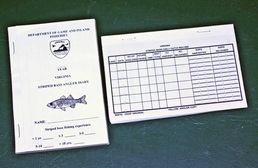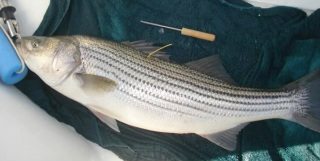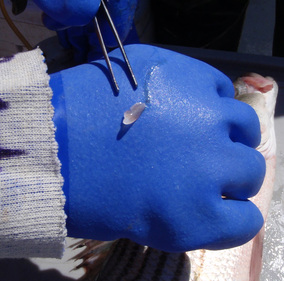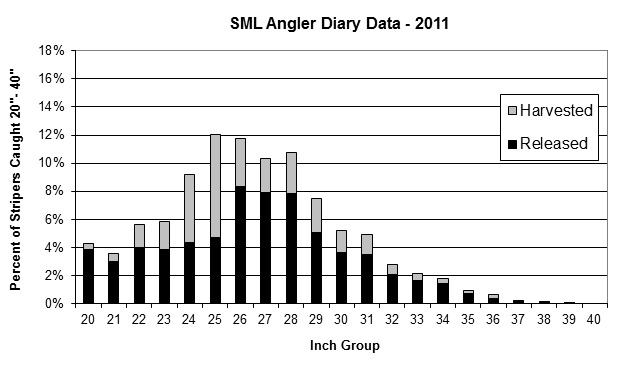Conservation Programs & VA DWR Partnership
Protecting SML's trophy striped bass fishery and helping ensure best practices management are foundational objectives which are at the core of Smith Mountain Lake Striper Club. The Club is pleased to work closely with the professional biologists and staff and VA Department of Wildlife Resources, DWR, on some of these initiatives.
SMSC thanks Dan Wilson, DWR Fisheries Biologist, for the excellent work that he and DWR are doing to maintain a truly spectacular trophy striped bass fishery at Smith Mountain Lake.
In the section below, you will find articles and links to a variety of resources related to the conservation and protection of our striped bass or other fisheries. We hope that whether as a club member or a SML visitor, you also will support sustainable fishing at the lake!
SMSC thanks Dan Wilson, DWR Fisheries Biologist, for the excellent work that he and DWR are doing to maintain a truly spectacular trophy striped bass fishery at Smith Mountain Lake.
In the section below, you will find articles and links to a variety of resources related to the conservation and protection of our striped bass or other fisheries. We hope that whether as a club member or a SML visitor, you also will support sustainable fishing at the lake!

Dan Wilson, Fisheries Biologist
Office 434-525-7522 / Mobile 434-942-0405 | dan.wilson@dwr.virginia.gov
Virginia Department of Wildlife Resources, 1132 Thomas Jefferson Road, Forest, VA 24551
Dan Wilson, Fisheries Biologist
Office 434-525-7522 / Mobile 434-942-0405 | dan.wilson@dwr.virginia.gov
Virginia Department of Wildlife Resources, 1132 Thomas Jefferson Road, Forest, VA 24551
VA DWR Annual Presentation to Smith Mountain Striper Club, 3/8/2024
Click on blue link below to access the full video recording of Nathan Smith's presentation, "Catch & Release Mortality of Striped Bass in Smith Mountain Lake", and Dan Wilson's presentation, "SML Striper Fishery Research and Trends". You can also click on each file to download a copy of the slides.
Presentation recordings from Nathan Smith and Dan Wilson on SMSC's Facebook page (double click on this link)
| Nathan Smith presentation: Striper Mortality at SML | |
| File Size: | 4688 kb |
| File Type: | |
| Dan Wilson presentation: 2024 SML Striper Growth & Stocking Plan | |
| File Size: | 3594 kb |
| File Type: | |
VA DWR Annual Presentation to Smith Mountain Striper Club, 3/3/2023
Click on blue link below to access the full video recording of Dan Wilson's presentation, "SML Striper Fishery Research and Trends", or click on the file below to read a written recap of the talk. You can also download the file to your computer for offline reading.
SMSC Facebook page. live stream of Dan Wilson presentation 3.3.2023
| Dan Wilson presentation: 2023 SML Striper Growth & Stocking Plan | |
| File Size: | 2279 kb |
| File Type: | |
VA DWR Annual Presentation to Smith Mountain Striper Club, 3/4/22
Click on the link below to access the full video recording of Dan Wilson's presentation, "SML Striper Fishery Research and Trends", or click on the file below to read a written recap of the talk. You can also download the file to your computer for offline reading.
SMSC Facebook page, live stream of Dan Wilson presentation 3.4.22
Click on the link below to access the full video recording of Dan Wilson's presentation, "SML Striper Fishery Research and Trends", or click on the file below to read a written recap of the talk. You can also download the file to your computer for offline reading.
SMSC Facebook page, live stream of Dan Wilson presentation 3.4.22
| dan_wilson_smsc_presentation_3.4.22.pdf | |
| File Size: | 252 kb |
| File Type: | |
SMSC Supports DWR Gill Netting and Striper Growth Research
| striper_science_at_sml_by_blake_nylund_11.2023.pdf | |
| File Size: | 2353 kb |
| File Type: | |
SML Striped Bass Management Videos
Below are 3 links for SMSC members and lake anglers to videos from DWR on Striped Bass management.
Feel free to contact Dan directly with any questions or comments using the info above. Enjoy these videos!
1- Sampling and management of reservoir striped bass:
https://www.facebook.com/VirginiaDWR/videos/744189692801024/?__so__=serp_videos_tab
2 - Striper broodstock collecting and hatching:
https://www.facebook.com/VirginiaDWR/videos/480117896611532/
3- Pond harvesting and stocking of striper bass in VA:
https://www.facebook.com/VirginiaDWR/videos/into-the-world-harvesting-and-releasing-striped-bass-at-dwr/155507409983304/?__so__=permalink&__rv__=related_videos
The document below contains important information about VA DWR's management of Striped Bass in Smith Mountain Lake.
This info is updated annually to include the latest information gathered from DWR field research.
Feel free to contact Dan directly with any questions or comments.
Below are 3 links for SMSC members and lake anglers to videos from DWR on Striped Bass management.
Feel free to contact Dan directly with any questions or comments using the info above. Enjoy these videos!
1- Sampling and management of reservoir striped bass:
https://www.facebook.com/VirginiaDWR/videos/744189692801024/?__so__=serp_videos_tab
2 - Striper broodstock collecting and hatching:
https://www.facebook.com/VirginiaDWR/videos/480117896611532/
3- Pond harvesting and stocking of striper bass in VA:
https://www.facebook.com/VirginiaDWR/videos/into-the-world-harvesting-and-releasing-striped-bass-at-dwr/155507409983304/?__so__=permalink&__rv__=related_videos
The document below contains important information about VA DWR's management of Striped Bass in Smith Mountain Lake.
This info is updated annually to include the latest information gathered from DWR field research.
Feel free to contact Dan directly with any questions or comments.
| sml_striped_bass_report_for_anglers_2020___va_dwr.pdf | |
| File Size: | 774 kb |
| File Type: | |
Sustainable Preservation Limits
(Adopted on 11/3/2017 by A Unanimous Vote of the Smith Mountain Striper Club Board of Directors & Supported by the Virginia Department of Wildlife Resources (VA DWR)
SUMMARY
Field research has shown there is an exceptionally high mortality rate (50-85% die) for striped bass caught from & released back into warm water (75 degrees or warmer). It is believed to be possible to achieve an improvement in the rate of striped bass preservation, & to increase the number of 3+ year old striped bass surviving in SML to catch in future years, by decreasing the number of striped bass caught per person during the warm water months of June through October.
During each of the past 5 years, striped bass anglers have caught fewer & fewer stripers per “angler day fished” (a 5-year cumulative decline of 46.5%). SML anglers have seldom caught more than 2 striped bass per day per person (7% in 2016). Therefore, adopting a new warm water catch limit of 2 striped bass per person per day will impact relatively few anglers. Most importantly, better stewardship of the limited & fragile striped bass population in SML will help preserve & protect the opportunity for everyone to catch striped bass on Smith Mountain Lake in the future.
Enforcement of the new warm water catch limit will be voluntary through education, self-discipline & enlightened self-interest. This change should complement, not take the place of, other efforts to increase the striped bass population in SML, such as improving the first-year “recruitment” (i.e., survival rate) of striped bass fry.
Download the full report on "Sustainable Preservation Limits" with detailed information & research on warm-water mortality here...
SUMMARY
Field research has shown there is an exceptionally high mortality rate (50-85% die) for striped bass caught from & released back into warm water (75 degrees or warmer). It is believed to be possible to achieve an improvement in the rate of striped bass preservation, & to increase the number of 3+ year old striped bass surviving in SML to catch in future years, by decreasing the number of striped bass caught per person during the warm water months of June through October.
During each of the past 5 years, striped bass anglers have caught fewer & fewer stripers per “angler day fished” (a 5-year cumulative decline of 46.5%). SML anglers have seldom caught more than 2 striped bass per day per person (7% in 2016). Therefore, adopting a new warm water catch limit of 2 striped bass per person per day will impact relatively few anglers. Most importantly, better stewardship of the limited & fragile striped bass population in SML will help preserve & protect the opportunity for everyone to catch striped bass on Smith Mountain Lake in the future.
Enforcement of the new warm water catch limit will be voluntary through education, self-discipline & enlightened self-interest. This change should complement, not take the place of, other efforts to increase the striped bass population in SML, such as improving the first-year “recruitment” (i.e., survival rate) of striped bass fry.
Download the full report on "Sustainable Preservation Limits" with detailed information & research on warm-water mortality here...
| Sustainable Preservation Limits | |
| File Size: | 446 kb |
| File Type: | |
VA DWR Angler Journal and Online Form

Become a better fisherman while helping the SML striper fishery!!
Keep a fishing journal to capture information to on what worked, when, how, etc. Your info is also valuable to the DWR biologist to help assess the state of the striped bass fishery at SML.
DWR provides a handy fishing log booklet which can be obtained at the Smith Mountain Striped Club meetings or by contacting DWR directly. This journal is simple to use, only requiring a minimal set of information on each trip.
This data provides very important information on the fishery and striped bass population that cannot be collected by any other method and helps guide stocking and management decisions. It is just as important to record those "skunk days" as it is those great days on the water, to determine the true “angler catch rate / hour”, a core management objective of DWR biologists.
SMSC proudly announces a new online form, now available to record your data from each fishing trip! Check it out at the link below:
Striped Bass Angler Journal (google.com)
Just use a Google gmail address to get started with your online SML striper journal.
If you choose the journal instead of the online form, bring it at year-end to a Club meeting, or mail it to VA DWR, c/o Dan Wilson, 1132 Thomas Jefferson Road, Forest, VA 24551.
Keep a fishing journal to capture information to on what worked, when, how, etc. Your info is also valuable to the DWR biologist to help assess the state of the striped bass fishery at SML.
DWR provides a handy fishing log booklet which can be obtained at the Smith Mountain Striped Club meetings or by contacting DWR directly. This journal is simple to use, only requiring a minimal set of information on each trip.
This data provides very important information on the fishery and striped bass population that cannot be collected by any other method and helps guide stocking and management decisions. It is just as important to record those "skunk days" as it is those great days on the water, to determine the true “angler catch rate / hour”, a core management objective of DWR biologists.
SMSC proudly announces a new online form, now available to record your data from each fishing trip! Check it out at the link below:
Striped Bass Angler Journal (google.com)
Just use a Google gmail address to get started with your online SML striper journal.
If you choose the journal instead of the online form, bring it at year-end to a Club meeting, or mail it to VA DWR, c/o Dan Wilson, 1132 Thomas Jefferson Road, Forest, VA 24551.
Fish Tagging

"There's gold in them there waters....." Well, maybe not gold ..... or is there.....), but there is money swimming around out there, just waiting for the right angler to find it. As a part of a conservation initiative by the VA DWR and various anglers on Smith Mountain Lake, a number of striped bass have been are tagged in order to obtain information on how anglers shape and impact the striped bass population. The tags will be found either just above the anal vent on the lower side of the fish, or on the top on either side of the dorsal fin and look similar in nature to yellow coffee stirrers (although depending on the duration to which these the tags have been on the fish they may be covered in some level of algae).
When an angler catches a tagged fish, the tag may be clipped off flush with the fish's body and the fish returned if practicing Catch & Release, or if the fish is harvested the tag can be removed upon cleaning. The angler should record the date, fish length, location (nearest channel marker) and note if the fish was harvested or released. Send this information, along with the anglers name and mailing address and the tag itself to the address listed on the tag (also listed below for convenience). There is a random reward of $5-$50 for each tag returned, along with information on the date and location where the fish was originally tagged. While the monetary reward is certainly nice, the information collected is invaluable to our local VDGIF Biologist and provides better management of the striped bass fishery at Smith Mountain Lake.
Return Tags to:
VA DWR
Dan Wilson, email address dan.wilson@dgif.virginia.gov
1132 Thomas Jefferson Rd
Forest, VA 24551
When an angler catches a tagged fish, the tag may be clipped off flush with the fish's body and the fish returned if practicing Catch & Release, or if the fish is harvested the tag can be removed upon cleaning. The angler should record the date, fish length, location (nearest channel marker) and note if the fish was harvested or released. Send this information, along with the anglers name and mailing address and the tag itself to the address listed on the tag (also listed below for convenience). There is a random reward of $5-$50 for each tag returned, along with information on the date and location where the fish was originally tagged. While the monetary reward is certainly nice, the information collected is invaluable to our local VDGIF Biologist and provides better management of the striped bass fishery at Smith Mountain Lake.
Return Tags to:
VA DWR
Dan Wilson, email address dan.wilson@dgif.virginia.gov
1132 Thomas Jefferson Rd
Forest, VA 24551
Fish Heads

No, we're not talking about making soup.... our goal here is to collect growth data on the fish in our striped bass fishery at Smith Mountain Lake. It turns out that striped bass are "related" to trees in that it is possible to age a fish by counting their "rings" - in the case of a striped bass it is the "rings" on the otolith bone - a small bone found within the ear of the fish. While the "rings" on the fish's scales have also been used as an indication of age, scales are not an accurate predictor of age for older fish. The otolith bone is a much more accurate indicator of age, which is vital for making sound management decisions.
Our local VDGIF Biologist would be happy to receive just the otolith bone from anglers, but it is a small bone that can be difficult to collect without some skill and knowledge. However, this information is valuable and a collection station have has been established where anglers can drop off fish heads from harvested fish so that they can be later processed to collect the otolith bone. When dropping off a fish head, be sure to provide the date the fish was caught along with the fish's length. If you include your name and/or e-mail contact information then once processed the VDGIF biologist will generally provide you with the details on the fish's age.
It is important for anglers to understand that collecting data in this manner allows VDGIF to gain insight on the growth rates of our fish in their mid and later years. Similar data is collected through the use of gill nets at various times of the year, but this generally produces data points on young fish up to 4 years of age, so the data from fish head collections is vital to understanding the on-going growth rates. Anglers are asked to collect only striped bass heads for fish 26 inches or larger. VDGIF has plenty of younger fish available but really needs the larger fish to monitor the entire population.
Summer time is an excellent time to collect fish heads due to the lower survivability rates of fish in warmer water and the increased rate of harvesting by many anglers. So in addition to enjoying a tasty filet of striper, consider taking a few extra minutes to detach the head, drop it in a freezer bag and then drop it off at one of the local drop-off locations.
Our local VDGIF Biologist would be happy to receive just the otolith bone from anglers, but it is a small bone that can be difficult to collect without some skill and knowledge. However, this information is valuable and a collection station have has been established where anglers can drop off fish heads from harvested fish so that they can be later processed to collect the otolith bone. When dropping off a fish head, be sure to provide the date the fish was caught along with the fish's length. If you include your name and/or e-mail contact information then once processed the VDGIF biologist will generally provide you with the details on the fish's age.
It is important for anglers to understand that collecting data in this manner allows VDGIF to gain insight on the growth rates of our fish in their mid and later years. Similar data is collected through the use of gill nets at various times of the year, but this generally produces data points on young fish up to 4 years of age, so the data from fish head collections is vital to understanding the on-going growth rates. Anglers are asked to collect only striped bass heads for fish 26 inches or larger. VDGIF has plenty of younger fish available but really needs the larger fish to monitor the entire population.
Summer time is an excellent time to collect fish heads due to the lower survivability rates of fish in warmer water and the increased rate of harvesting by many anglers. So in addition to enjoying a tasty filet of striper, consider taking a few extra minutes to detach the head, drop it in a freezer bag and then drop it off at one of the local drop-off locations.
Drop off Locations:
We are currently looking for new drop-off locations - stay tuned.....
Otolith picture credit of the New Jersey Division of Fish & Wildlife - http://www.nj.gov/dep/fgw/artstrpbass10.htm
Striper Management Data
The two documents attached are the latest information capturing the various collected data on the striper fishery, used by our DGIF Biologist to aid in his management of the fishery. Information on stocking, gill-net surveys, angler diaries, fish-head collections and others are captured in these documents.
|
| ||||||||||||


